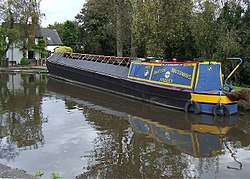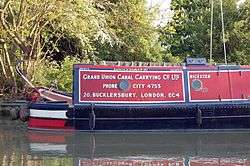Grand Union Canal Carrying Company
The Grand Union Canal Carrying Company was a freight carrying transport service in England from 1934 to 1948.

Background
For more detail on this section see the History of the Grand Union Canal.
In 1929 the Regents Canal bought the Grand Junction Canal and a new company the Grand Union Canal was established. Later that year the new company bought the Warwick Canals.
In 1932 the Grand Union Canal bought the Leicester and Loughborough Navigations and the Erewash Canal for £75,423 (equivalent to £5,270,000 in 2019).[1]
For the first time the main line from London to Birmingham and the River Trent were all owned by one company with the exception of the Oxford Canal between Braunston and Napton. The Grand Union Company attempted to buy the Oxford Canal but the agreement failed.
The Grand Union Canal was now over 300 miles long. A main objective was to create a route capable of taking 14 ft barges or two narrow boats from London to Birmingham.
Formation of the company

The new company bought Associated Canal Carriers Ltd. and started the Grand Union Canal Carrying Company Ltd in 1934.[2] The boats were marked with GUCCC as an abbreviation for the company name.
The company secured new traffic in the 1930s and ordered new boats from W.J. Yarwood & Sons of Northwich, Harland and Wolff at Woolwich and W.H. Walker and Brothers of Rickmansworth.[3] Eventually the company acquired around 186 pairs of boats of a new improved design. The boats acquired the nicknames Woolwichs, Northwichs and Rickys.
Decline and closure
With the outbreak of World War II men again left the canal. In 1942 the Ministry of War Transport took control. For the duration of the war the company made a loss. The assets were taken over by the British Transport Commission on 1 January 1949.[4]
References
- UK Retail Price Index inflation figures are based on data from Clark, Gregory (2017). "The Annual RPI and Average Earnings for Britain, 1209 to Present (New Series)". MeasuringWorth. Retrieved 2 February 2020.
- British waterways: an illustrated history. David Daniel Francis Gladwin
- Living the dream. Trevor Pavitt. ISBN 1-84753-757-X
- The Dock and Harbour Authority, 30, 1949